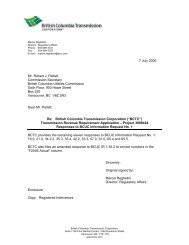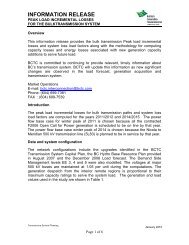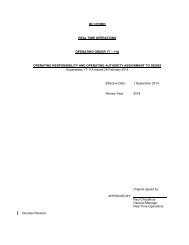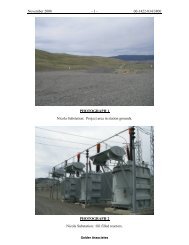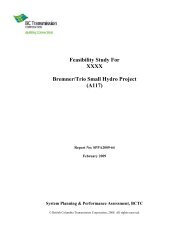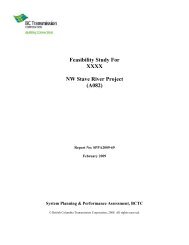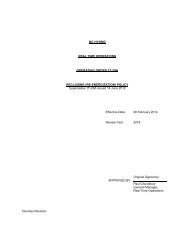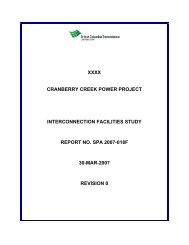Evidence on the Adequacy of First Nations Consultation - BC Hydro ...
Evidence on the Adequacy of First Nations Consultation - BC Hydro ...
Evidence on the Adequacy of First Nations Consultation - BC Hydro ...
You also want an ePaper? Increase the reach of your titles
YUMPU automatically turns print PDFs into web optimized ePapers that Google loves.
DRAFT REPORT: Rights and Title Interests in <strong>the</strong> Columbia Valley Transmissi<strong>on</strong> Project Area<br />
Schaeffer was told by those he interviewed that “prior to <strong>the</strong> opening <strong>of</strong> <strong>the</strong> 19 th century,” <strong>the</strong><br />
“Columbia Lakes” area 205 was <strong>on</strong>e <strong>of</strong> <strong>the</strong> four Upper Kutenai “populati<strong>on</strong>al loci.” The o<strong>the</strong>r three<br />
“populati<strong>on</strong>al loci” were identified by Schaeffer as: <strong>the</strong> Crows Nest Pass or Michel Prairie area;<br />
<strong>the</strong> Tobacco Plains area <strong>on</strong> both sides <strong>of</strong> what is now <strong>the</strong> Canada/United States boundary; and,<br />
<strong>the</strong> area around Libby, M<strong>on</strong>tana. Schaeffer went <strong>on</strong> to say that:<br />
Each <strong>on</strong>e <strong>of</strong> <strong>the</strong>se localities was strategically located for <strong>the</strong> exploitati<strong>on</strong><br />
<strong>of</strong> an important food resource: salm<strong>on</strong> <strong>on</strong> <strong>the</strong> uppermost Columbia, bis<strong>on</strong><br />
in <strong>the</strong> Crows Nest Pass regi<strong>on</strong>, camas, bitterroot and berries at Tobacco<br />
Plains, and deer in <strong>the</strong> Libby-Jennings secti<strong>on</strong>. 206<br />
The “Columbia Lakes Band,” Schaeffer wrote, was actually comprised <strong>of</strong> two separate groups <strong>of</strong><br />
Kutenai who had <strong>the</strong>ir main campsites in this locality at different periods:<br />
a) Kátamukinik, <strong>the</strong> earlier people, named from <strong>the</strong>ir camp site (kátamu) located<br />
<strong>on</strong> <strong>the</strong> Columbia River immediately south <strong>of</strong> <strong>the</strong> mouth <strong>of</strong> Toby Creek. They<br />
were a small group <strong>of</strong> Upper Kutenai, whose ec<strong>on</strong>omic activities were carried<br />
out al<strong>on</strong>g <strong>the</strong> north-south axis <strong>of</strong> <strong>the</strong> Kootenai-Columbia valley, with eastwest<br />
excursi<strong>on</strong>s across <strong>the</strong> Rockies to <strong>the</strong> bis<strong>on</strong> range. They subsisted more<br />
up<strong>on</strong> fish than game. They are said to have spoken Tunáxa. 207<br />
b) Akískənəkinik, “people <strong>of</strong> <strong>the</strong> two lakes,” <strong>the</strong> successor group, which had its<br />
main camp near Fairm<strong>on</strong>t Springs [Fairm<strong>on</strong>t Hot Springs] between Columbia<br />
and Windermere Lakes. 208<br />
C<strong>on</strong>cerning <strong>the</strong> earlier group, <strong>the</strong> “kátamukinik”, sometimes called <strong>the</strong> “Toby Creek Kutenai,” 209<br />
Schaeffer reported <strong>the</strong>y spent November and December at Tobacco Plains or Libby, M<strong>on</strong>tana.<br />
After New Year, some <strong>of</strong> <strong>the</strong>m travelled to <strong>the</strong> Toby Creek area (“kátamu”, from which this<br />
group took <strong>the</strong>ir name) where <strong>the</strong>y spent January through March hunting bighorn sheep and<br />
waterfowl. The “kátamukinik” spent <strong>the</strong> m<strong>on</strong>ths <strong>of</strong> August through September in <strong>the</strong> Columbia<br />
205 In earlier times, what is known today as “Lake Windermere” was referred to as “Lower Columbia<br />
Lake,” and what is today “Columbia Lake” was known as “Upper Columbia Lake.”<br />
206 Schaeffer 1934-1969, Reel 1.<br />
207 The Roberts<strong>on</strong> study states that this band is now comprised “<strong>of</strong> <strong>the</strong> Shuswap descendants <strong>of</strong> <strong>the</strong><br />
Kinbasket clan, who have intermarried with <strong>the</strong> Ktunaxa, Colville, and St<strong>on</strong>ey people, as well as Ktunaxa<br />
descendants <strong>of</strong> <strong>the</strong> Columbia Lake Band near Windermere, <strong>BC</strong>.” It is said to c<strong>on</strong>sist <strong>of</strong> <strong>the</strong> former Toby Creek and<br />
Whiteswan Lake bands ((Roberts<strong>on</strong> 2007:1).<br />
“kátamukinik”.<br />
208 Schaeffer 1934-1969, Reel 1.<br />
209 Schaeffer (1934-1969, Reel 2) also transcribed <strong>the</strong> name for <strong>the</strong>se people as “katamukínik” ra<strong>the</strong>r than<br />
Bouchard & Kennedy Research C<strong>on</strong>sultants Page 49<br />
Page 52 <strong>of</strong> 200






